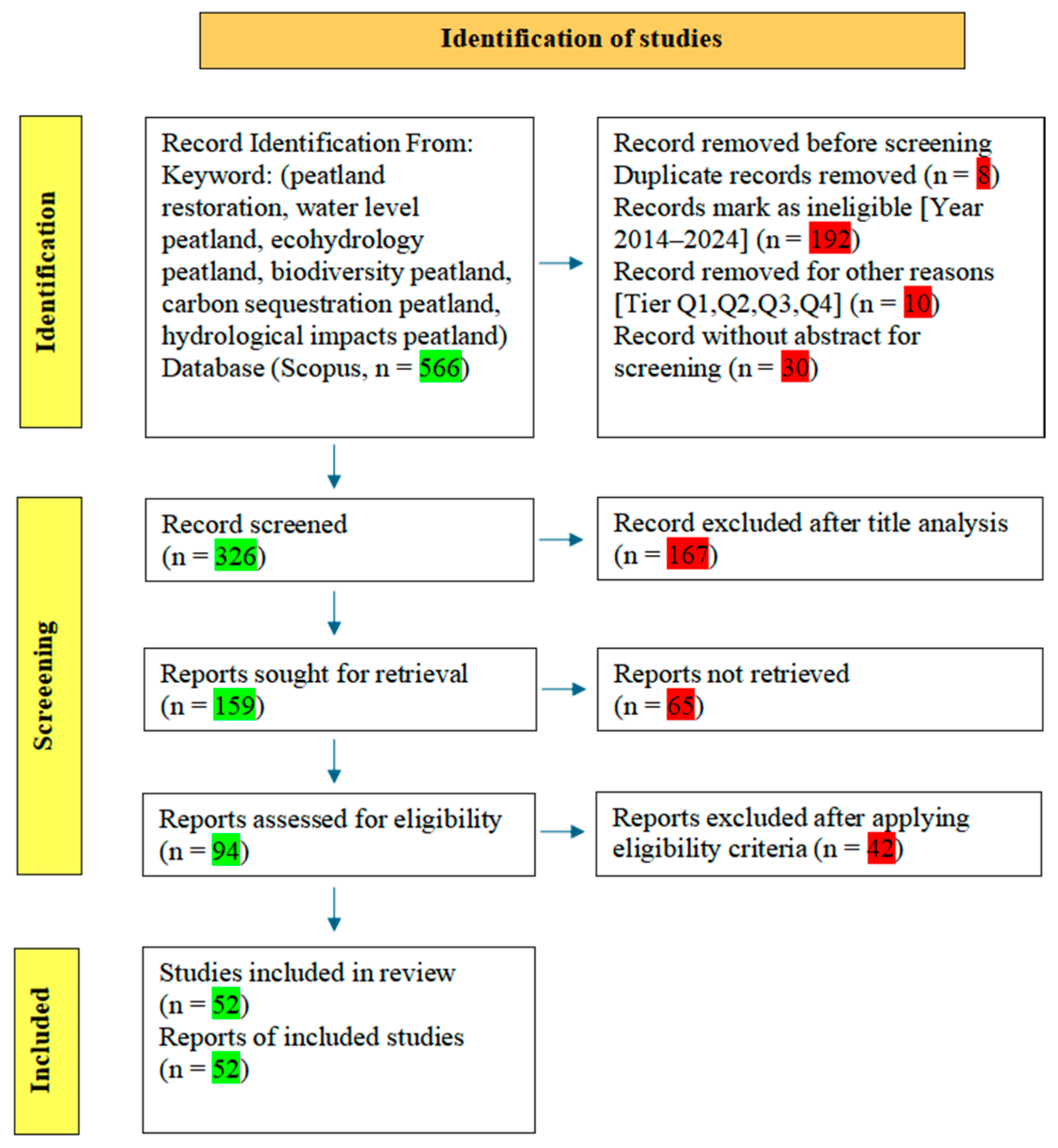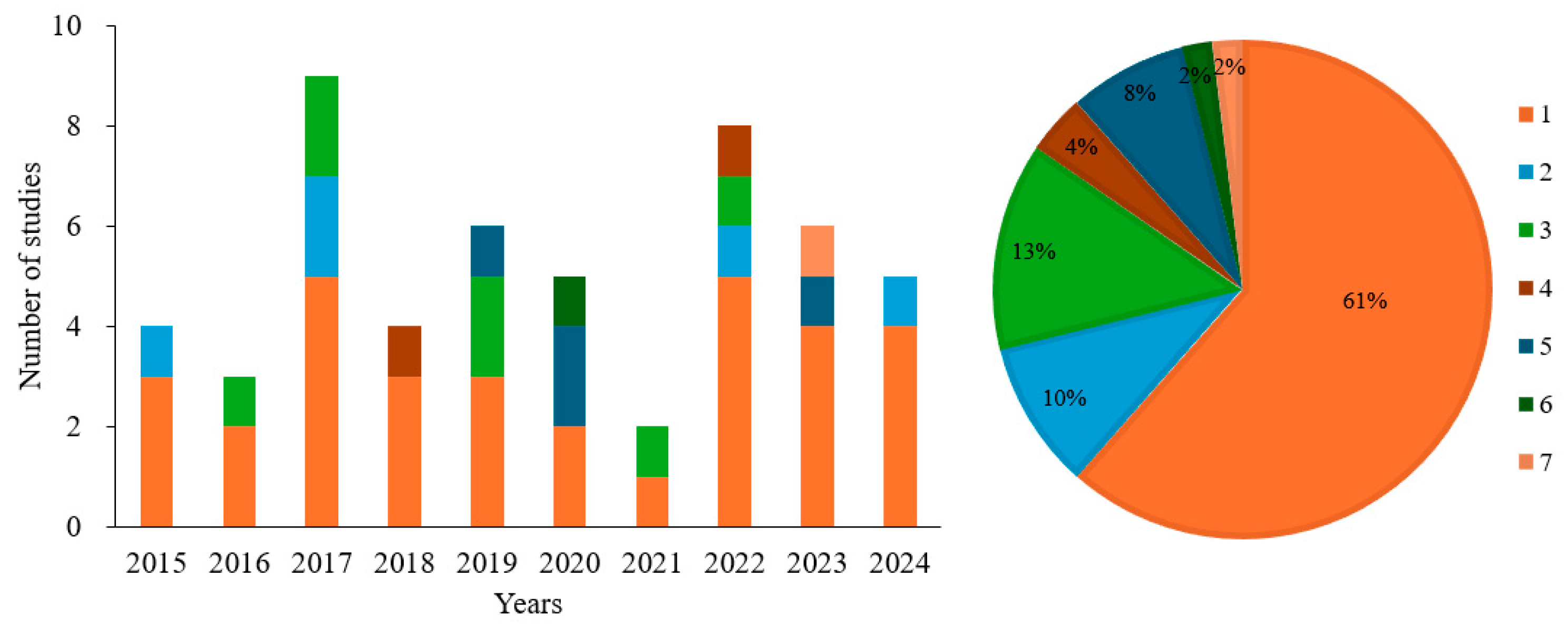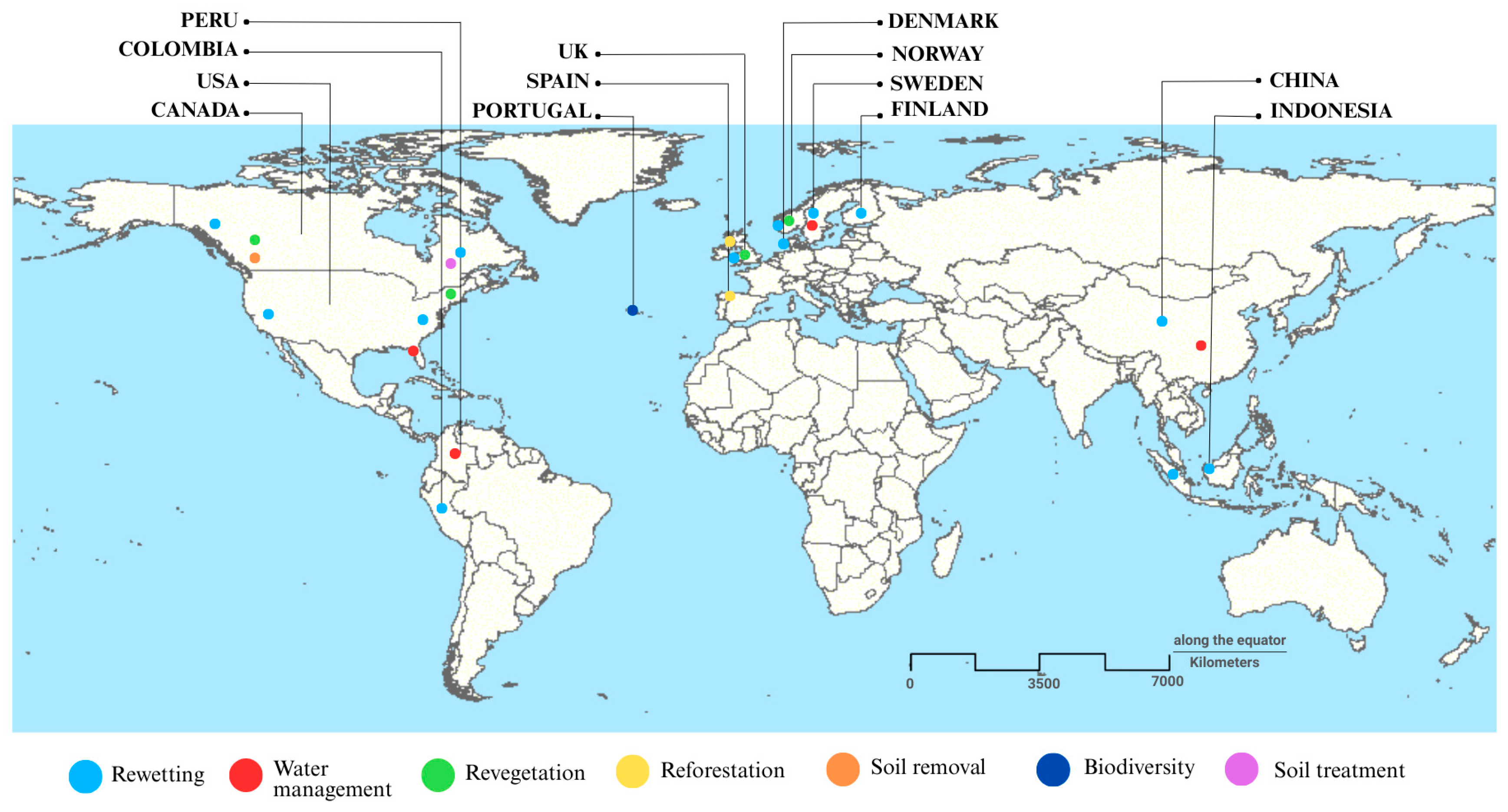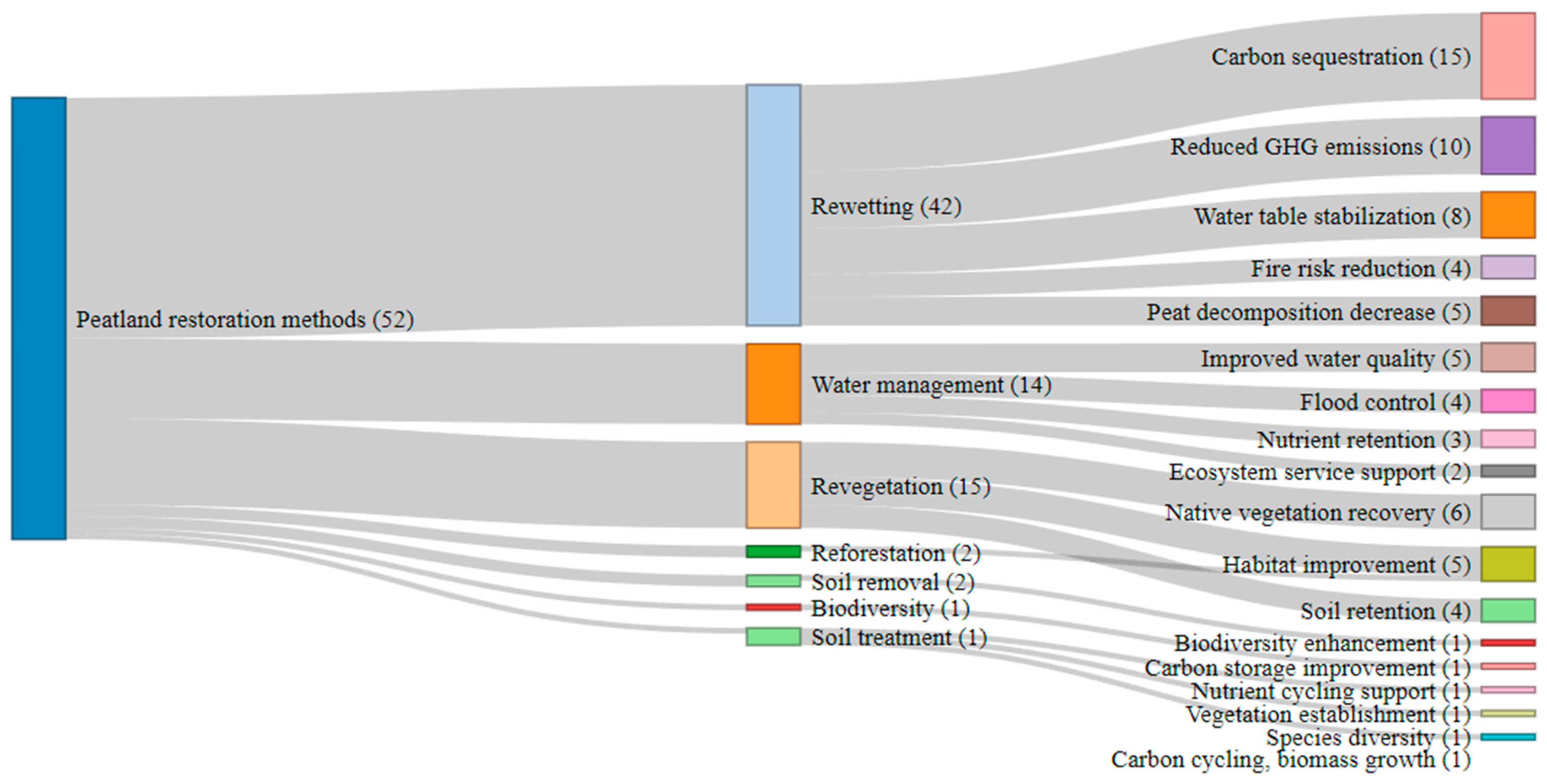Issues of Peatland Restoration Across Scales: A Review and Meta-Analysis
Abstract
1. Introduction
2. Materials and Methods
2.1. Justification and Scope of the Review
2.2. Systematic Search Design
2.3. Screening and Eligibility Criteria
2.4. Meta-Analysis Approach
3. Results
3.1. Spatial and Temporal Patterns
3.2. Averaged Indicators of Peatland Restoration
4. Discussion
5. Conclusions
Author Contributions
Funding
Data Availability Statement
Conflicts of Interest
References
- Allan, J.M.; Guêné-Nanchen, M.; Rochefort, L.; Douglas, D.J.T.; Axmacher, J.C. Meta-Analysis Reveals That Enhanced Practices Accelerate Vegetation Recovery during Peatland Restoration. Restor. Ecol. 2024, 32, e14015. [Google Scholar] [CrossRef]
- Kopansky, D.; Reed, M.; Kaplan, M.; Hughes, J.; Nuutinen, M.; Peters, J.; Barthelmes, A.; Salathe, T.; Miles, L.; Tamelander, J.; et al. Global Peatlands Assessment—The State of the World’s Peatlands: Evidence for Action Toward the Conservation, Restoration, and Sustainable Management of Peatlands; UN Environment Programme: Nairobi, Kenya, 2022; ISBN 978-92-807-3991-6. [Google Scholar]
- Hooijer, A.; Vernimmen, R.; Mulyadi, D.; Triantomo, V.; Hamdani; Lampela, M.; Agusti, R.; Page, S.E.; Doloksaribu, J.; Setiawan, I.; et al. Benefits of Tropical Peatland Rewetting for Subsidence Reduction and Forest Regrowth: Results from a Large-Scale Restoration Trial. Sci. Rep. 2024, 14, 10721. [Google Scholar] [CrossRef]
- McCarter, C.P.; Clay, G.D.; Wilkinson, S.L.; Sigmund, G.; Davidson, S.J.; Taufik, M.; Page, S.; Shuttleworth, E.L.; McLagan, D.; Chenier, G. Peat Fires and Legacy Toxic Metal Release: An Integrative Biogeochemical and Ecohydrological Conceptual Framework. Earth-Sci. Rev. 2024, 256, 104867. [Google Scholar] [CrossRef]
- Home|Global Peatlands Initiative. Available online: https://globalpeatlands.org/ (accessed on 25 July 2025).
- Alshehri, A.; Dunn, C.; Freeman, C.; Hugron, S.; Jones, T.G.; Rochefort, L. A Potential Approach for Enhancing Carbon Sequestration During Peatland Restoration Using Low-Cost, Phenolic-Rich Biomass Supplements. Front. Environ. Sci. 2020, 8, 48. [Google Scholar] [CrossRef]
- Young, D.M.; Baird, A.J.; Morris, P.J.; Holden, J. Simulating the Long-term Impacts of Drainage and Restoration on the Ecohydrology of Peatlands. Water Resour. Res. 2017, 53, 6510–6522. [Google Scholar] [CrossRef]
- Dohong, A.; Abdul Aziz, A.; Dargusch, P. A Review of Techniques for Effective Tropical Peatland Restoration. Wetlands 2018, 38, 275–292. [Google Scholar] [CrossRef]
- Kulik, M.; Urban, D.; Grzywaczewski, G.; Bochniak, A.; Grzywna, A.; Sender, J. Half a Century of Wetland Degradation: The Present State and Trends of Changes in Western Polesie—Long-Term Wetland Degradation. Glob. Ecol. Conserv. 2024, 56, e03324. [Google Scholar] [CrossRef]
- Beaulne, J.; Garneau, M.; Magnan, G.; Boucher, É. Peat Deposits Store More Carbon than Trees in Forested Peatlands of the Boreal Biome. Sci. Rep. 2021, 11, 2657. [Google Scholar] [CrossRef]
- Loisel, J.; Gallego-Sala, A. Ecological Resilience of Restored Peatlands to Climate Change. Commun. Earth Environ. 2022, 3, 208. [Google Scholar] [CrossRef]
- Zhang, M.; Smol, J.P.; Liu, W.; Wang, L. Climatic Changes Control the Net Carbon Sequestration Rates of Carex-Dominated Peatlands in Northeast Asia. Quat. Sci. Rev. 2025, 351, 109184. [Google Scholar] [CrossRef]
- Jaenicke, J.; Englhart, S.; Siegert, F. Monitoring the Effect of Restoration Measures in Indonesian Peatlands by Radar Satellite Imagery. J. Environ. Manag. 2011, 92, 630–638. [Google Scholar] [CrossRef]
- Stachowicz, M.; Lyngstad, A.; Osuch, P.; Grygoruk, M. Hydrological Response to Rewetting of Drained Peatlands—A Case Study of Three Raised Bogs in Norway. Land 2025, 14, 142. [Google Scholar] [CrossRef]
- Grygoruk, M.; Bańkowska, A.; Jabłońska, E.; Janauer, G.A.; Kubrak, J.; Mirosław-Świątek, D.; Kotowski, W. Assessing Habitat Exposure to Eutrophication in Restored Wetlands: Model-Supported Ex-Ante Approach to Rewetting Drained Mires. J. Environ. Manag. 2015, 152, 230–240. [Google Scholar] [CrossRef] [PubMed]
- Koch, J.; Elsgaard, L.; Greve, M.H.; Gyldenkærne, S.; Hermansen, C.; Levin, G.; Wu, S.; Stisen, S. Water-Table-Driven Greenhouse Gas Emission Estimates Guide Peatland Restoration at National Scale. Biogeosciences 2023, 20, 2387–2403. [Google Scholar] [CrossRef]
- Mander, Ü.; Espenberg, M.; Melling, L.; Kull, A. Peatland Restoration Pathways to Mitigate Greenhouse Gas Emissions and Retain Peat Carbon. Biogeochemistry 2023, 167, 523–543. [Google Scholar] [CrossRef] [PubMed]
- Grand-Clement, E.; Anderson, K.; Smith, D.; Angus, M.; Luscombe, D.J.; Gatis, N.; Bray, L.S.; Brazier, R.E. New Approaches to the Restoration of Shallow Marginal Peatlands. J. Environ. Manag. 2015, 161, 417–430. [Google Scholar] [CrossRef]
- Menberu, M.W.; Haghighi, A.T.; Ronkanen, A.; Marttila, H.; Kløve, B. Effects of Drainage and Subsequent Restoration on Peatland Hydrological Processes at Catchment Scale. Water Resour. Res. 2018, 54, 4479–4497. [Google Scholar] [CrossRef]
- Glina, B.; Bogacz, A.; Mendyk, Ł.; Bojko, O.; Nowak, M. Effectiveness of Restoration of a Degraded Shallow Mountain Fen after Five Years. Mires Peat 2018, 21, 1–15. [Google Scholar] [CrossRef]
- Ojanen, P.; Minkkinen, K.; Penttilä, T. The Current Greenhouse Gas Impact of Forestry-Drained Boreal Peatlands. For. Ecol. Manag. 2013, 289, 201–208. [Google Scholar] [CrossRef]
- Peltoniemi, M.; Li, Q.; Turunen, P.; Tupek, B.; Mäkiranta, P.; Leppä, K.; Müller, M.; Rissanen, A.J.; Laiho, R.; Anttila, J.; et al. Soil GHG Dynamics after Water Level Rise—Impacts of Selection Harvesting in Peatland Forests. Sci. Total Environ. 2023, 901, 165421. [Google Scholar] [CrossRef]
- Lazcano, C.; Robinson, C.; Hassanpour, G.; Strack, M. Short-Term Effects of Fen Peatland Restoration through the Moss Layer Transfer Technique on the Soil CO2 and CH4 Efflux. Ecol. Eng. 2018, 125, 149–158. [Google Scholar] [CrossRef]
- Schmidt, M.; Davidson, S.J.; Strack, M. CO2 Uptake Decreased and CH4 Emissions Increased in First Two Years of Peatland Seismic Line Restoration. Wetl. Ecol. Manag. 2022, 30, 313–329. [Google Scholar] [CrossRef]
- Waddington, J.M.; Warner, K.D.; Kennedy, G.W. Cutover Peatlands: A Persistent Source of Atmospheric CO2. Glob. Biogeochem. Cycles 2002, 16, 1–7. [Google Scholar] [CrossRef]
- Andersen, R.; Farrell, C.; Graf, M.; Muller, F.; Calvar, E.; Frankard, P.; Caporn, S.; Anderson, P. An Overview of the Progress and Challenges of Peatland Restoration in Western Europe. Restor. Ecol. 2017, 25, 271–282. [Google Scholar] [CrossRef]
- Strzęciwilk, K.; Grygoruk, M. Restoration Is an Investment. Comparing Restoration Costs and Ecosystem Services in Selected European Wetlands. J. Water Land Dev. 2025, 221–229. [Google Scholar] [CrossRef]
- Mursyid, H.; Ramadhan, R.; Irawan, A.; Sadono, R.; Susila Putra, E.T.; Suryanto, P. A Global Development and Dynamics of Peatland Restoration: A Bibliometric Analysis. Ecol. Indic. 2025, 177, 113724. [Google Scholar] [CrossRef]
- Chimner, R.; Cooper, D.; Wurster, F.; Rochefort, L. An Overview of Peatland Restoration in North America: Where Are We after 25 Years? Restor. Ecol. 2016, 25, 283–292. [Google Scholar] [CrossRef]
- Apori, S.O.; Mcmillan, D.; Giltrap, M.; Tian, F. Mapping the Restoration of Degraded Peatland as a Research Area: A Scientometric Review. Front. Environ. Sci. 2022, 10, 942788. [Google Scholar] [CrossRef]
- Kreyling, J.; Tanneberger, F.; Jansen, F.; van der Linden, S.; Aggenbach, C.; Blüml, V.; Couwenberg, J.; Emsens, W.-J.; Joosten, H.; Klimkowska, A.; et al. Rewetting Does Not Return Drained Fen Peatlands to Their Old Selves. Nat. Commun. 2021, 12, 5693. [Google Scholar] [CrossRef]
- Karimi, S.; Maher Hasselquist, E.; Salimi, S.; Järveoja, J.; Laudon, H. Rewetting Impact on the Hydrological Function of a Drained Peatland in the Boreal Landscape. J. Hydrol. 2024, 641, 131729. [Google Scholar] [CrossRef]
- Budiningsih, K.; Putera, P.B.; Nurlia, A.; Ulya, N.A.; Nurfatriani, F.; Salminah, M.; Yuniati, D.; Widarti, A. Peatland Restoration Research: A Global Overview with Insights from Indonesia. J. Ecol. Environ. 2024, 48, 27. [Google Scholar] [CrossRef]
- 2006 IPCC Guidelines for National Greenhouse Gas Inventories—IPCC. Available online: https://www.ipcc-nggip.iges.or.jp/public/2006gl/ (accessed on 25 July 2025).
- D’Acunha, B.; Lee, S.; Johnson, M.S. Ecohydrological Responses to Rewetting of a Highly Impacted Raised Bog Ecosystem. Ecohydrology 2018, 11, e1922. [Google Scholar] [CrossRef]
- Menberu, M.W.; Marttila, H.; Tahvanainen, T.; Kotiaho, J.S.; Hokkanen, R.; Kløve, B.; Ronkanen, A.-K. Changes in Pore Water Quality After Peatland Restoration: Assessment of a Large-Scale, Replicated Before-After-Control-Impact Study in Finland. Water Resour. Res. 2017, 53, 8327–8343. [Google Scholar] [CrossRef]
- Planas-Clarke, A.M.; Chimner, R.A.; Hribljan, J.A.; Lilleskov, E.A.; Fuentealba, B. The Effect of Water Table Levels and Short-Term Ditch Restoration on Mountain Peatland Carbon Cycling in the Cordillera Blanca, Peru. Wetl. Ecol. Manag. 2020, 28, 51–69. [Google Scholar] [CrossRef]
- Strack, M.; Zuback, Y.; McCarter, C.; Price, J. Changes in Dissolved Organic Carbon Quality in Soils and Discharge 10years after Peatland Restoration. J. Hydrol. 2015, 527, 345–354. [Google Scholar] [CrossRef]
- Zak, D.; McInnes, R.J. A Call for Refining the Peatland Restoration Strategy in Europe. J. Appl. Ecol. 2022, 59, 2698–2704. [Google Scholar] [CrossRef]
- Engering, A.; Davidson, S.J.; Xu, B.; Bird, M.; Rochefort, L.; Strack, M. Restoration of a Boreal Peatland Impacted by an in-situ Oil Sands w ell-pad 2: Greenhouse Gas Exchange Dynamics. Restor. Ecol. 2022, 30, e13508. [Google Scholar] [CrossRef]
- Gaffney, P.P.J.; Hancock, M.H.; Taggart, M.A.; Andersen, R. Restoration of Afforested Peatland: Immediate Effects on Aquatic Carbon Loss. Sci. Total Environ. 2020, 742, 140594. [Google Scholar] [CrossRef]
- Knox, S.H.; Sturtevant, C.; Matthes, J.H.; Koteen, L.; Verfaillie, J.; Baldocchi, D. Agricultural Peatland Restoration: Effects of Land-use Change on Greenhouse Gas (CO2 and CH4) Fluxes in the Sacramento-San Joaquin Delta. Glob. Change Biol. 2015, 21, 750–765. [Google Scholar] [CrossRef]
- Swindles, G.T.; Green, S.M.; Brown, L.; Holden, J.; Raby, C.L.; Turner, T.E.; Smart, R.; Peacock, M.; Baird, A.J. Evaluating the Use of Dominant Microbial Consumers (Testate Amoebae) as Indicators of Blanket Peatland Restoration. Ecol. Indic. 2016, 69, 318–330. [Google Scholar] [CrossRef]
- Worrall, F.; Howden, N.J.K.; Burt, T.P.; Rico-Ramirez, M.A.; Kohler, T. Local Climate Impacts from Ongoing Restoration of a Peatland. Hydrol. Process. 2022, 36, e14496. [Google Scholar] [CrossRef]
- Guo, J.; Jiang, H.; Bian, H.; He, C.; Gao, Y. Effects of Hydrologic Mediation and Plantation of Carex Schmidtii Meinsh on Peatland Restoration in China’s Changbai Mountain Region. Ecol. Eng. 2016, 96, 187–193. [Google Scholar] [CrossRef]
- Guo, J.; Jiang, H.; Bian, H.; Sheng, L.; He, C.; Gao, Y. Natural Succession Is a Feasible Approach for Cultivated Peatland Restoration in Northeast China. Ecol. Eng. 2017, 104, 39–44. [Google Scholar] [CrossRef]
- Julian, P.; Gerber, S.; Wright, A.L.; Gu, B.; Osborne, T.Z. Carbon Pool Trends and Dynamics within a Subtropical Peatland during Long-Term Restoration. Ecol. Process. 2017, 6, 43. [Google Scholar] [CrossRef]
- Villa, J.A.; Mejía, G.M.; Velásquez, D.; Botero, A.; Acosta, S.A.; Marulanda, J.M.; Osorno, A.M.; Bohrer, G. Carbon Sequestration and Methane Emissions along a Microtopographic Gradient in a Tropical Andean Peatland. Sci. Total Environ. 2019, 654, 651–661. [Google Scholar] [CrossRef]
- Edokpa, D.A.; Evans, M.G.; Allott, T.E.H.; Pilkington, M.; Rothwell, J.J. Peatland Restoration and the Dynamics of Dissolved Nitrogen in Upland Freshwaters. Ecol. Eng. 2017, 106, 44–54. [Google Scholar] [CrossRef]
- Salimi, S.; Scholz, M. Importance of Water Level Management for Peatland Outflow Water Quality in the Face of Climate Change and Drought. Environ. Sci. Pollut. Res. 2022, 29, 75455–75470. [Google Scholar] [CrossRef]
- Shah, N.W.; Nisbet, T.R. The Effects of Forest Clearance for Peatland Restoration on Water Quality. Sci. Total Environ. 2019, 693, 133617. [Google Scholar] [CrossRef]
- Yan, L.; Zhang, X.; Wu, H.; Kang, E.; Li, Y.; Wang, J.; Yan, Z.; Zhang, K.; Kang, X. Disproportionate Changes in the CH4 Emissions of Six Water Table Levels in an Alpine Peatland. Atmosphere 2020, 11, 1165. [Google Scholar] [CrossRef]
- Jiménez-González, M.A.; Boubehziz, S.; Álvarez, A.M.; Carral, P.; Marqués-Pérez, M.J.; Abd-Elmabod, S.K.; Almendros, G. Evaluation of Topsoil Carbon Content and Quality in a Peatland and Reforested Soil after 50 Years of Soil Restoration in the Sierra de Guadarrama National Park (Spain). Sustainability 2023, 15, 16312. [Google Scholar] [CrossRef]
- Gatis, N.; Benaud, P.; Anderson, K.; Ashe, J.; Grand-Clement, E.; Luscombe, D.J.; Puttock, A.; Brazier, R.E. Peatland Restoration Increases Water Storage and Attenuates Downstream Stormflow but Does Not Guarantee an Immediate Reversal of Long-Term Ecohydrological Degradation. Sci. Rep. 2023, 13, 15865. [Google Scholar] [CrossRef] [PubMed]
- Howson, T.; Evans, M.; Allott, T.; Shuttleworth, E.; Johnston, A.; Rees, J.; Milledge, D.; Edokpa, D.; Lockyer, C.; Kay, M.; et al. Peatland Gully Restoration with Stone and Timber Dams (Kinder Plateau, UK). Ecol. Eng. 2023, 195, 107066. [Google Scholar] [CrossRef]
- Robins, L.; Van Kerkhoff, L.; Rochmayanto, Y.; Sakuntaladewi, N.; Agrawal, S. Knowledge Systems Approaches for Enhancing Project Impacts in Complex Settings: Community Fire Management and Peatland Restoration in Indonesia. Reg. Environ. Change 2022, 22, 100. [Google Scholar] [CrossRef] [PubMed]
- Ulya, N.A.; Martin, E.; Rahmat, M.; Premono, B.T.; Malau, L.R.E.; Waluyo, E.A.; Imanullah, A.; Lukman, A.H.; Asmaliyah; Armansyah; et al. Enabling Factors of NTFP Business Development for Ecosystem Restoration: The Case of Tamanu Oil in Indonesian Degraded Peatland. Sustainability 2022, 14, 10681. [Google Scholar] [CrossRef]
- Marlier, M.E.; Liu, T.; Yu, K.; Buonocore, J.J.; Koplitz, S.N.; DeFries, R.S.; Mickley, L.J.; Jacob, D.J.; Schwartz, J.; Wardhana, B.S.; et al. Fires, Smoke Exposure, and Public Health: An Integrative Framework to Maximize Health Benefits from Peatland Restoration. GeoHealth 2019, 3, 178–189. [Google Scholar] [CrossRef]
- Osaki, M. 2013 Supplement to the 2006 IPCC Guidelines for National Greenhouse Gas Inventories: Wetlands Methodological Guidance on Lands with Wet and Drained Soils, and Constructed Wetlands for Wastewater Treatment; Intergovernmental Panel on Climate Change: Geneva, Switzerland, 2014. [Google Scholar]
- Reddin, E.; Hanafin, J.; Tong, M.; Gill, L.; Healy, M.G. Modelling Water Table Depth at Rewetted Peatlands with Sentinel-1 and Sentinel-2. Sci. Remote Sens. 2025, 11, 100238. [Google Scholar] [CrossRef]
- Günther, A.; Barthelmes, A.; Huth, V.; Joosten, H.; Jurasinski, G.; Koebsch, F.; Couwenberg, J. Prompt Rewetting of Drained Peatlands Reduces Climate Warming despite Methane Emissions. Nat. Commun. 2020, 11, 1644. [Google Scholar] [CrossRef]
- Dhandapani, S.; Evers, S.; Boyd, D.; Evans, C.D.; Page, S.; Parish, F.; Sjogersten, S. Assessment of Differences in Peat Physico-Chemical Properties, Surface Subsidence and GHG Emissions between the Major Land-Uses of Selangor Peatlands. CATENA 2023, 230, 107255. [Google Scholar] [CrossRef]
- Cooper, H.V.; Evers, S.; Aplin, P.; Crout, N.; Dahalan, M.P.B.; Sjogersten, S. Greenhouse Gas Emissions Resulting from Conversion of Peat Swamp Forest to Oil Palm Plantation. Nat. Commun. 2020, 11, 407. [Google Scholar] [CrossRef]
- Evans, C.D.; Williamson, J.M.; Kacaribu, F.; Irawan, D.; Suardiwerianto, Y.; Hidayat, M.F.; Laurén, A.; Page, S.E. Rates and Spatial Variability of Peat Subsidence in Acacia Plantation and Forest Landscapes in Sumatra, Indonesia. Geoderma 2019, 338, 410–421. [Google Scholar] [CrossRef]
- Utstøl-Klein, S.; Halvorsen, R.; Ohlson, M. Increase in Carbon Accumulation in a Boreal Peatland Following a Period of Wetter Climate and Long-Term Decrease in Nitrogen Deposition. New Phytol. 2015, 206, 1238–1246. [Google Scholar] [CrossRef] [PubMed]
- Bring, A.; Thorslund, J.; Rosén, L.; Tonderski, K.; Åberg, C.; Envall, I.; Laudon, H. Effects on Groundwater Storage of Restoring, Constructing or Draining Wetlands in Temperate and Boreal Climates: A Systematic Review. Environ. Evid. 2022, 11, 38. [Google Scholar] [CrossRef] [PubMed]
- Chasmer, L.; Mahoney, C.; Millard, K.; Nelson, K.; Peters, D.; Merchant, M.; Hopkinson, C.; Brisco, B.; Niemann, O.; Montgomery, J. Remote Sensing of Boreal Wetlands 2: Methods for Evaluating Boreal Wetland Ecosystem State and Drivers of Change. Remote Sens. 2020, 12, 1321. [Google Scholar] [CrossRef]
- National Audit Office (NAO). Government’s Approach to the Environment and Climate Change 2023–2024—NAO Overview; National Audit Office (NAO): London, UK, 2024. [Google Scholar]
- Grayson, R.; Holden, J.; Martin-Ortega, J.; Bice, R.; Leadbitter, P.; Glenk, K.; Cohen, J.; Blundell, A.; Brown, L.; Morris, P.; et al. White Paper on the Requirements for Upscaled Peatland Restoration in Upland England. Available online: https://eprints.whiterose.ac.uk/id/eprint/224034/ (accessed on 25 July 2025).
- Webster, K.L.; Strack, M.; Balliston, N.; Davies, M.A.; Hettinga, E.K.; Hunter, M.; Yin, X. Data and knowledge needs for improving science and policy for peatlands in Canada in a changing world: Insights from Global Peatlands Initiative Workshop, June 2023. FACETS 2025, 10, 1–19. [Google Scholar] [CrossRef]
- Puspitaloka, D.; Kim, Y.-S.; Purnomo, H.; Fulé, P.Z. Analysis of Challenges, Costs, and Governance Alternative for Peatland Restoration in Central Kalimantan, Indonesia. Trees For. People 2021, 6, 100131. [Google Scholar] [CrossRef]
- Atkinson, C.L.; Alibašić, H. Prospects for Governance and Climate Change Resilience in Peatland Management in Indonesia. Sustainability 2023, 15, 1839. [Google Scholar] [CrossRef]




| Parameter | CO2 | CH4 | Carbon Sequestration | WTD |
|---|---|---|---|---|
| (kg·ha−1·Year−1) | (kg·ha−1·Year−1) | (kg·ha−1·Year−1) | (cm) | |
| I2 | 66.67% | 75.10% | 50.05% | 85.71% |
| p-value | 0.049 | 0.007 | 0.157 | <0.0001 |
| SD | 26 408 | 257 | 23 574 | 8.44 |
| Average | 53 857 | 486 | 23 030 | 10.45 |
| Peatland Restoration Consequences | Findings | Refs. |
|---|---|---|
| Water Table (WT) Changes | Restoration appeared to enhance carbon sequestration in many areas, though not always consistently or significantly. A recurring pattern was the reduction of CO2 emissions after rewetting, but this was often offset, at least partially, by a rise in CH4, especially in persistently saturated conditions. Methane variability also depended on plant type and water level stability | [3,8,14,19,24,35,36,37,38,39] |
| Carbon Sequestration and GHG Emissions | Restoration appeared to enhance carbon sequestration in many areas, though not always consistently or significantly. A recurring pattern was the reduction of CO2 emissions after rewetting, but this was often offset, at least partially, by a rise in CH4, especially in persistently saturated conditions. Methane variability also depended on plant type and water level stability | [16,17,36,38,40,41,42,43,44] |
| Vegetation Recovery | Some restored peatlands showed clear signs of vegetation returning, particularly mosses like Sphagnum and sedges such as Carex. However, in several cases, the pace of recovery was slower than expected. Factors like site history and soil chemistry likely played a role in shaping these outcomes. | [1,3,19,24,26,43,45,46,47,48] |
| Nutrient Dynamics (N, P, DOC) | The effects of restoration on nutrients such as nitrogen and phosphorus were mixed. Some studies reported a rise in nutrient concentrations, while others observed declines. Similarly, dissolved organic carbon (DOC) quality improved in some sites; however, it remained variable elsewhere, suggesting the response is not universal. | [6,36,38,39,49,50,51,52] |
| Soil Properties and Hydrology | Changes to soil characteristics post-restoration were generally positive, with increases in organic matter and moisture retention in many cases. Bulk density decreased slightly in some locations, though not all studies reported structural improvements. There was also some evidence of surface emission reductions, but again, this varied by site. | [22,37,38,44,45,50,53] |
| Hydrological Flows and Ecological Improvements | Flood attenuation was reported in multiple cases, with some sites showing up to a 49% reduction in peak discharge. Seasonal water balance seemed to normalize over time, although responses varied depending on topography and rewetting method. Fire risk tended to drop where rewetting succeeded, and some signs of improved biodiversity were noted. | [32,54,55,56,57] |
| Climate and Temperature Effects | In some studies, the cooler surface temperatures were observed after restoration, especially in wetter sites. However, these patterns were not consistent across all sites and may be linked to increased soil moisture levels post-rewetting. A few observations also mentioned brighter, more reflective surfaces after rewetting, possibly due to vegetation changes, which could affect how much heat is absorbed. | [22,44,58] |
Disclaimer/Publisher’s Note: The statements, opinions and data contained in all publications are solely those of the individual author(s) and contributor(s) and not of MDPI and/or the editor(s). MDPI and/or the editor(s) disclaim responsibility for any injury to people or property resulting from any ideas, methods, instructions or products referred to in the content. |
© 2025 by the authors. Licensee MDPI, Basel, Switzerland. This article is an open access article distributed under the terms and conditions of the Creative Commons Attribution (CC BY) license (https://creativecommons.org/licenses/by/4.0/).
Share and Cite
Kustina, R.; Pilicita, J.C.; Grygoruk, M. Issues of Peatland Restoration Across Scales: A Review and Meta-Analysis. Water 2025, 17, 2428. https://doi.org/10.3390/w17162428
Kustina R, Pilicita JC, Grygoruk M. Issues of Peatland Restoration Across Scales: A Review and Meta-Analysis. Water. 2025; 17(16):2428. https://doi.org/10.3390/w17162428
Chicago/Turabian StyleKustina, Rinda, Jessica Canchig Pilicita, and Mateusz Grygoruk. 2025. "Issues of Peatland Restoration Across Scales: A Review and Meta-Analysis" Water 17, no. 16: 2428. https://doi.org/10.3390/w17162428
APA StyleKustina, R., Pilicita, J. C., & Grygoruk, M. (2025). Issues of Peatland Restoration Across Scales: A Review and Meta-Analysis. Water, 17(16), 2428. https://doi.org/10.3390/w17162428







